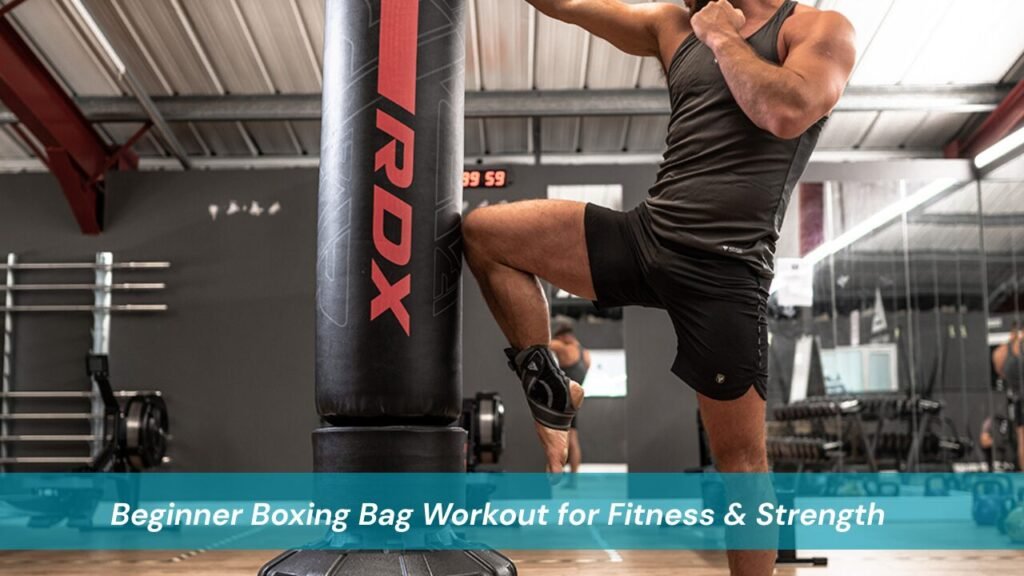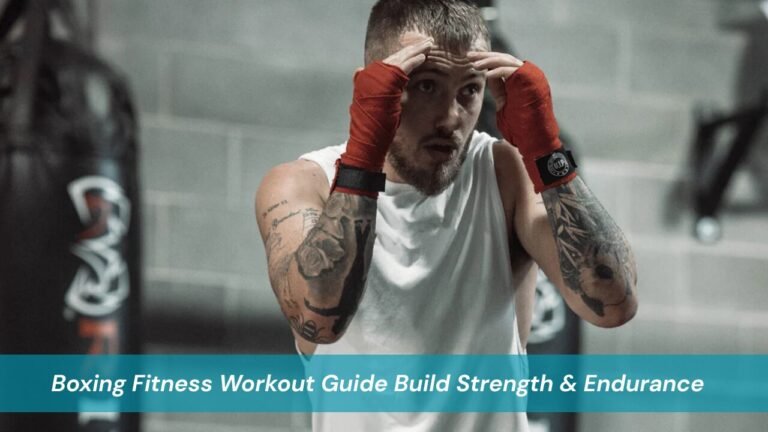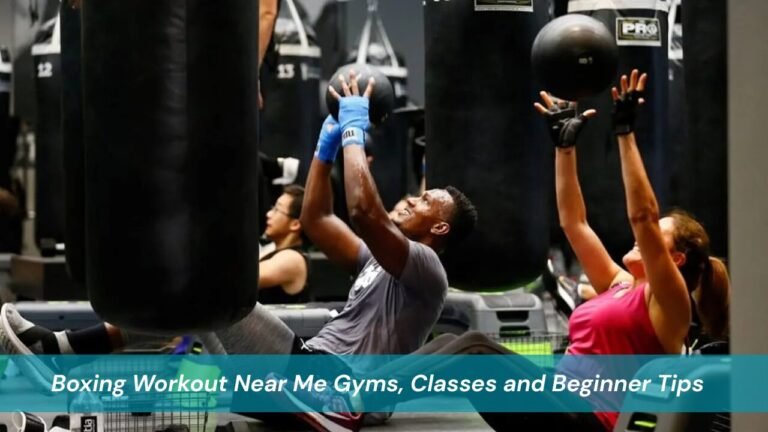Boxing is one of the oldest and most effective ways to train the body and mind. From improving cardiovascular health to building confidence, it provides benefits that go far beyond the ring. For beginners, the heavy bag is often the first step into the sport. A beginner boxing bag workout teaches the fundamentals of movement, power, and endurance in a safe and structured way. Unlike sparring, which requires a partner, the bag is always available and patient, making it the perfect training partner for newcomers.
This guide explores everything you need to know about starting your heavy bag journey. From the benefits and equipment you’ll need, to a complete workout routine and common mistakes to avoid, you’ll leave with a clear plan to begin training like a fighter even if you’ve never thrown a punch before.
Why Start with a Beginner Boxing Bag Workout?
For someone stepping into the world of boxing, the heavy bag offers immediate advantages. It acts as both a target and a teacher. Each strike against the bag provides instant feedback on power, accuracy, and form. When you hit it wrong, your wrist may bend or the punch may lack force. When you hit it correctly, you feel the solid thud of connection, the way a well-thrown punch should sound and feel.
Bag workouts also allow beginners to practice safely without the unpredictability of a live opponent. Shadowboxing, while valuable, lacks the resistance and physical presence that the bag provides. The bag absorbs energy, swings, and demands that you maintain balance and control skills that translate directly to real boxing scenarios.
In terms of fitness, heavy bag training is a full-body workout. Each punch involves not just the arms, but also the shoulders, chest, back, hips, and legs. The rotational power needed to generate force comes from the core, while the footwork required to stay balanced builds lower body strength. Cardiovascularly, few exercises rival boxing. Just three rounds of bag work can leave a beginner dripping in sweat and gasping for breath, much like an intense HIIT session.
Beyond the physical, there’s the psychological benefit. Hitting the bag is a stress reliever. The rhythmic sound of fists pounding leather becomes meditative, and the release of endorphins helps boost mood. Many beginners report increased confidence after just a few weeks of consistent training.
Essential Gear Before You Start
To make the most of your workout and avoid injuries, it’s important to start with the right equipment. The most essential piece is a good pair of boxing gloves. For beginners, gloves in the 12–16 oz range are ideal because they provide enough padding to protect your hands and wrists during impact. Underneath the gloves, hand wraps are critical. They secure the small bones in the hands and stabilize the wrists, which are particularly vulnerable for those who are just learning proper punching technique.
Of course, you also need a heavy bag. Bags between 70 and 100 pounds are considered best for beginners. They are heavy enough to provide resistance without swinging wildly after each punch, which can throw off balance. A bag that’s too light will move excessively, forcing you to chase it rather than focus on technique.
Footwear is another detail that beginners often overlook. While running shoes might seem like a good choice, they are not designed for lateral movement or pivoting. Lightweight sneakers or boxing shoes are better because they provide traction without sticking to the floor, allowing for smooth pivots and quick steps.
Finally, a timer is useful. Boxing is structured around rounds, and using a timer helps simulate real training conditions. Many boxing apps allow you to set round lengths and rest periods, making it easy to stay consistent without constantly looking at a clock.
Beginner Boxing Bag Workout Routine
Now that you’re geared up, it’s time to hit the bag. A good beginner boxing bag workout should balance simplicity with structure. The goal is not to throw as many punches as possible but to build technique, rhythm, and stamina.
Start with three rounds, each lasting two minutes, with one minute of rest in between. Over time, you can build up to three-minute rounds, which is the standard in amateur and professional boxing.
In the first round, focus on the jab. The jab is the foundation of boxing and will become your most used punch. Stand in your stance, with your lead hand extended in a straight punch toward the bag. Step slightly forward with each jab, then move laterally around the bag. This round should be less about power and more about rhythm. Keep your guard up and practice returning your hand to your chin after every punch.
The second round adds the cross to the mix. This is where you begin throwing the classic one-two combination. After a jab, rotate your rear shoulder forward and throw a straight cross with your back hand. Remember that the power comes from your hips and legs, not just your arm. After each combo, reset your stance and breathe. Exhaling with each punch helps maintain rhythm and endurance.
In the third round, add the hook. Now your combination becomes a jab-cross-hook. The hook is thrown with the lead hand, and it requires rotation of the hips and a pivot of the lead foot. Beginners often make the mistake of arm-punching their hooks. Instead, focus on turning your entire body into the punch. This will make it feel powerful without straining your shoulder.
Beginner-Friendly Heavy Bag Drills
In addition to structured rounds, drills can make training more dynamic and fun. A simple yet effective drill for beginners is the punch-out drill. For thirty seconds, throw continuous punches without stopping. The goal is not maximum power but constant movement. This builds stamina and simulates the fatigue you’ll feel in later rounds of training or sparring.
Another useful drill is the defense drill. Many beginners focus only on offense and forget that boxing is as much about avoiding punches as it is about throwing them. To practice defense on the bag, imagine it as an opponent. After each jab-cross, slip your head to the left or right as if avoiding a counterpunch. This trains the habit of moving defensively after attacking.
A power punch drill is also effective. For twenty seconds, focus exclusively on throwing hard crosses and hooks. This teaches you how to generate maximum force while maintaining control. It’s also a great way to build explosive strength.
Lastly, a footwork drill helps beginners understand movement. Instead of standing still, move around the bag. Step in, throw a jab, then step back out. Circle to your left, throw a jab-cross, then pivot to the right. This trains you to use the bag as a stand-in opponent rather than a stationary target.
Pro Tips for Success
Success in boxing isn’t about who hits hardest but who trains smartest. Beginners often chase the bag, moving wherever it swings. This wastes energy and breaks rhythm. Instead, let the bag swing naturally and time your punches so that you meet it on its return.
Another mistake is tension. Beginners tend to tighten their shoulders and throw stiff punches. This not only drains energy quickly but also slows down combinations. Relaxation is key. The best fighters look effortless because they allow their bodies to move fluidly.
Form is more important than power, especially in the beginning. Many beginners try to throw every punch as hard as possible. The result is sloppy technique and sore wrists. Focus on accuracy, timing, and balance first. Power will come naturally once form is mastered.
Keeping track of progress is also helpful. Recording your workouts on video allows you to analyze mistakes and improvements. Alternatively, keeping a simple training log of rounds completed, combinations practiced, and how you felt during the session provides motivation and structure.
Finally, never skip warm-ups and cool-downs. Jumping rope, light shadowboxing, or mobility drills prepare the body for impact. Cooling down with stretches reduces soreness and lowers the risk of injury. Boxing is demanding, and your body will thank you for proper care.
Common Mistakes Beginners Should Avoid
One of the most common mistakes beginners make is relying solely on arm strength. A proper punch comes from the ground up, starting with the legs, rotating through the hips, and transferring energy through the torso into the fist. Throwing only arm punches not only limits power but increases the chance of injury.
Another frequent error is dropping the hands after throwing punches. This leaves the face exposed and builds bad habits that become difficult to break later. Always return the hands to guard after each punch, no matter how tired you feel.
Standing flat-footed is another pitfall. Good boxing relies on staying light on the toes, ready to move in any direction. Beginners who plant their feet too heavily often find themselves off balance when the bag swings back or when trying to pivot.
Breathing is another overlooked aspect. Many beginners hold their breath while punching, leading to early fatigue. Exhaling sharply with each punch helps maintain energy and keeps movements sharp.
Lastly, skipping defense entirely is a mistake. Even though the bag doesn’t hit back, training defensive movements early creates muscle memory that will become invaluable when facing real opponents.
FAQs
How long should a beginner train on the heavy bag?
A good starting point is fifteen to twenty minutes per session, two to three times per week. This allows the body to adapt without overtraining. As stamina improves, beginners can extend sessions to thirty minutes or more.
Do I need a coach to start heavy bag training?
While a coach provides valuable feedback, beginners can safely start on their own using online tutorials, instructional videos, and structured routines like the one outlined above. However, eventually seeking guidance from an experienced trainer is highly recommended to refine technique.
Can boxing bag workouts help with weight loss?
Yes. Boxing is one of the most calorie-burning activities. A half-hour bag workout can burn between 300 and 500 calories, depending on intensity. Combined with a healthy diet, this makes boxing an excellent choice for fat loss.
What muscles does a punching bag workout train?
Although punches appear to come from the arms, the reality is that heavy bag training works the entire body. The shoulders and chest generate much of the force, but the core stabilizes and transfers energy, while the legs and hips provide rotational power. Even the back muscles play a role in maintaining posture and balance.
Conclusion
Starting a beginner boxing bag workout is an exciting step toward better health, strength, and confidence. The heavy bag teaches not only how to punch harder but how to move smarter. With the right equipment, a structured routine, and consistent practice, progress comes quickly.
The key is patience. No one becomes a skilled boxer overnight. But every round on the bag builds stamina, improves technique, and instills discipline. Whether your goal is to lose weight, build fitness, or eventually step into the ring, bag training lays the foundation. Visit Boxing Essential to explore more.




